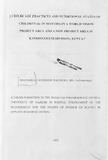Childcare practices and nutritional status of Children (6- 59 months) in a world vision Project area and a non-project area in Kathonzweni division, kenya
Abstract
In August-September 2000, a comparative cross-sectional survey aimed at assessmg and
comparing childcare practices and nutritional status of children (6-59 months) drawn from
households participating in a World Vision project vis-a-vis non-project area was conducted
in Kithuki, Kanthuni and Kathonzweni locations of Kathonzweni division, Makueni district.
The principal tool of investigation was a structured questionnaire that was administered to
mothers and other children caretakers. Methods used were anthropometric measurements and
dietary intake recall. Purposive sampling was done at the programme level whereas simple
random sampling was done at the household level giving a sample size of 320 households in
which there had to be a child aged between 6-59 months. In households with more than one
child at this age category, only one child was picked as the index child and preferably the
elder one. A sub-sample of 60 households was randomly selected for the 24-hour dietary
recall. Data was collected with assistance of two field assistants and the SPSS/PC+ computer
package was used for data entry and analysis. Nutritional status indices such as weight-forage,
height-for-age and weight-for-height were computed using the Epi-Info programme.
The study established that there was no significant difference in prevalence of stunting,
wasting and underweight between the two areas. However, the prevalence of stunting in the
project area (46.5%) was slightly higher than in the non-project area (42.1 %). The study
found that there was a significant relationship between the children's age and their nutritional
status based on the level of wasting and underweight (p<O.OI) suggesting that there is
something about age that reduces risk to wasting and underweight and this could probably be
in relation to the palatability of the food given to children with age increase. A significant
relationship between childbirth order and nutritional status based on stunting was found
xi
indicating that as the birth order increased, the chances of stunting increased. This could be
attributed to the fact that as the childbirth order increases, then the possibility of having more
people sharing from the same pot increases thus increasing the risk of malnutrition due to
chronic shortage of food.
A significantly higher proportion of children in the non-project area (63.8%) than in the
project area (375%) were introduced to complementary foods within the first three months
(p=O.OO) indicating that exclusive breastfeeding within the first six months was not a
common practice and the projects health education on supplementation initiation may have
had a positive effect. For both of the study groups the main food first given to children was
un-enriched cereal porridge while protein foods and fruits were rarely used as complementary
foods.
Although not significant a higher proportion of households in the project area (47.5%) use
enclosures as latrines compared to the non-project area (36.9%). Slightly less than 'a'balf of
the children in both the project area (43%) and non-project area (36.9%) were reportedly ill
within two weeks preceding the survey. Symptoms of upper respiratory tract infections were
the most common in both study areas. Grandmothers were reported to be the main alternative
caregivers though most of the mothers prepared food for the children while other caretakers
did the actual feeding.
Finally, no significant difference was noted in both the childcare practices and nutritional
status in the two areas contrary to what may have been expected. Therefore, the alternative
hypotheses are rejected and the null hypotheses that "there was no difference in the childcare
practices and nutritional status in the two areas" accepted.
xii
It is therefore recommended that mothers be encouraged to exclusively breast feed for at least
the first four months and continue breastfeeding preferably to the second year. This could be
achieved by making them understand why it is a good strategy. Other recommendations
include provision of safe water sources and pit latrines to the community as well as
conducting regular nutritional surveillance.
Citation
MSc.Sponsorhip
University of NairobiPublisher
Department of applied human nutrition

